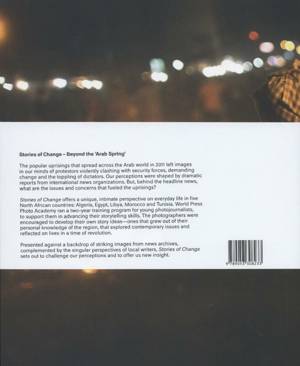
- Retrait en 2 heures
- Assortiment impressionnant
- Paiement sécurisé
- Toujours un magasin près de chez vous
- Retrait gratuit dans votre magasin Club
- 7.000.0000 titres dans notre catalogue
- Payer en toute sécurité
- Toujours un magasin près de chez vous


Description
The Arab Spring is among the most thoroughly photographed events in recent history. People in the streets using their mobile phones to register incidents they were eyewitness to, local journalists as well as camera crews and freelance photographers dispatched by international media recording the developments from day to day. Our perception of the Arab Spring is marked by dramatic images of key moments during the uprisings. Demonstrators taking over Tahrir Square in Cairo and engaging in violent clashes with the security forces and supporters of President Mubarak; the storming of Colonel Gaddafi's compound in Tripoli, Libya, by rebels and the capture of the leader himself weeks later. Major changes in the power relations have taken place since then: in Egypt and Tunisia, the resignation of the country's president, and in Libya, the fall of the leader and the first free elections in 60 years. In other countries, protests have not led to a revolution, but they are facing challenges from local issues and from the effects of the global economic crisis. How well do we know the region beyond the headlines though? What has been the impact of the events on people's everyday lives? Many of the issues that fuelled the uprisings remain unresolved: a high level of youth unemployment, the rising cost of living, women's rights etc. What is really going on in the homes and in the streets of the cities in the region? What do people worry or dream about? STORIES OF CHANGE challenges our perceptions of the region and brings to the foreground a local perspective in reporting. Through stories produced exclusively for this book, and shown here for the first time, we are offered an insider view into the lives of people in a region that rarely has left news headlines, but that only few of us know beyond the one-dimensional headline news images flashed on our screens. STORIES OF CHANGE celebrates authenticity in visual storytelling, showing us North Africa through the eyes of a group of photo-journalists from the region. They are all top alumni of a series of workshops conducted in 2012 and 2013 by World Press Photo for photographers from five participating countries: Morocco, Algeria, Tunisia, Libya, and Egypt.
Spécifications
Parties prenantes
- Auteur(s) :
- Editeur:
Contenu
- Nombre de pages :
- 312
- Langue:
- Anglais
Caractéristiques
- EAN:
- 9789053308233
- Date de parution :
- 01-09-14
- Format:
- Livre broché
- Format numérique:
- Trade paperback (VS)
- Dimensions :
- 195 mm x 252 mm
- Poids :
- 1192 g

Seulement chez Librairie Club
+ 166 points sur votre carte client de Librairie Club
Les avis
Nous publions uniquement les avis qui respectent les conditions requises. Consultez nos conditions pour les avis.







